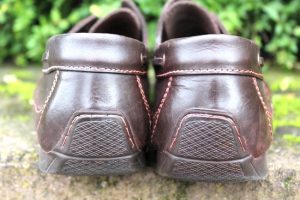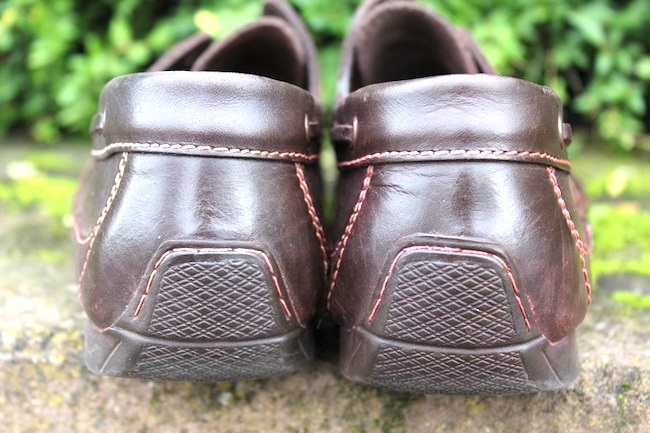
These divrei Torah were adapted from the hashkafa portion of Rabbi Yissocher Frand’s Commuter Chavrusah Tapes on the weekly portion: #1276 — Cap and Gown at Graduation: Is There A Halachic Problem? Good Shabbos!
I would like to begin my remarks by sharing a true story that I experienced. Some time ago, I was in Europe for the summer as a scholar in residence on a tour of different European cities. One of the countries we visited was Hungary. The tour arrived at the banks of the Danube River in Budapest, at what is called “The Shoe Memorial.” A very famous sculptor created a formation of metal shoes secured to the ground along the Danube.
Up until 1944, Adolph Hitler had a peace treaty with Hungary. That is why the Hungarian Jews were not directly affected by the Holocaust until 1944. Jews in Poland and Germany and all over Europe were already rounded up for execution several years earlier, but Hungarian Jews initially escaped exportation because of Hitler’s peace treaty with Hungary.
In 1944, Hitler broke the peace treaty, and it became open season on Hungarian Jews, who were deported to concentration camps in 1944 and 1945. Adolph Eichman was in charge of exporting and exterminating Hungarian Jewry. When the treaty was originally broken, there was a Fascist group in Hungary called the Arrow-Cross, which could not wait for Germany’s exportations, and they started killing Jews themselves in Hungary itself.
They would line up Jews on the banks of the Danube River and mow them down. The Jews fell backwards into the river giving rise to the famous quote – the Blue Danube literally turned red! But before the Arrow-Cross murderers did that, they made the Jews take off their shoes. Shoes were precious in those days, and they wanted to salvage the Jews’ shoes for themselves.
To commemorate this horrible genocide, the above-mentioned sculptor went ahead and fashioned a twenty-foot section of the embankment with various shoes – of men, women, and children.
Our group went to this very moving site. I pointed out the irony that even though this was not the intention of the Arrow-Cross, “The place where we are standing is a makom kadosh (holy place).” Why did I call it a holy place? It is because any Jew who is killed simply because he is a Jew is a kadosh. He has died al pi Kiddush Hashem (as a martyr who sanctifies G-d’s Name).
In this week’s parsha, regarding a holy place, the pasuk says “Do not draw near, remove your shoes from your feet for the place which you stand upon is holy ground.” (Shemos 3:5). It is ironic. In this particular place, by the banks of the Danube River, the Jews took off their shoes. I was not suggesting to our group that they should take off their shoes. But I made the comment that there is something else that we can learn from that incident where Moshe Rabbeinu was told to take off his shoes at the Burning Bush:
We all know the story. Moshe Rabbeinu saw a burning bush – one of the iconic images of the story of Yetzias Mitzrayim. The pasuk says, “And Hashem saw that Moshe turned to draw near and investigate…” (Shemos 3:4) Both the pasuk and Chazal make a big deal of the fact that Moshe Rabbeinu went to check it out. But let us ask: What is the big deal here? Wouldn’t anyone seeing a burning bush that was not being consumed try to get a better look and check out what was happening? Of course they would! People run to view a burning building which defies no laws of nature. Here, a miraculous event was transpiring. Certainly, any person would want to go and investigate the matter!
The Sforno on that pasuk makes the following comment: “He went to see what was happening – l’his’bonen ba’davar (to contemplate upon the matter). Moshe was not just interested in the sight. L’his’bonen ba’davar means he wanted to comprehend “What does this mean? What is the significance of the phenomenon I am witnessing?” Moshe understood that he was being sent a message. The Ribono shel Olam was making an open miracle, which He does not do on a daily basis. “What is the Ribono shel Olam telling me?”
That was the greatness of Moshe Rabbeinu. He saw something noteworthy and it immediately prompted him to ask himself – What is the Ribono shel Olam trying to tell me?
The Ribono shel Olam was trying to tell Moshe that this burning bush, which was not being consumed, was going to represent the history of Klal Yisrael. We went down to Mitzrayim and the Egyptians tried to eradicate us, but we survived. This is something that has been going on for the last three thousand years. Whether it was the Egyptian exile, the Babylonian exile, the Greek exile, or the Roman exile; whether it was the destruction of the batei mikdash, whether it was the Crusades, the Spanish Inquisition, the decrees of Tac”h v’Ta”t (1648/1649), or whether it was the Holocaust, they have tried to eradicate us just like in Mitzrayim. BUT THE BUSH WAS NOT CONSUMED. That is the defining visual icon of Klal Yisrael. They can keep trying to burn us, but the bush will not be consumed. This is the message that Moshe Rabbeinu took out of this incident.
This tour in Hungary that I accompanied took place in July 2014. The previous March, there was a conference of European rabbis, who held a ceremony at the site of this Shoe Memorial, commemorating the 70th anniversary of the start of the deportation of Hungarian Jewry. The Kalover Rebbe (Menachem Mendel Taub, 1923-2018) was present at that ceremony. The Kalover Rebbe was a Hungarian rav, who was deported to Auschwitz. He survived the war and then became a Rebbe of Kalover Chassidim in Yerushalayim. He spoke at that ceremony commemorating what had happened there seventy years earlier!
The Kalover Chassidim have a niggun which many people may have heard. It is actually a Hungarian tune, without Jewish origin, but it has been adopted by Kalover Chassidim. The Kalover Rebbe got up at this anniversary commemoration and sang this niggun. It was incredibly moving that there were a group of young boys, ten- or eleven-year-old Hungarian boys, cheder boys with long payos, singing this song together with their Rebbe.
If there was ever an embodiment of “the bush could not be consumed,” this was it! Seventy years earlier, the Fascists tried to eradicate Hungarian Jewry, along with the rest of world Jewry. And here we were, seventy years later. The old Kalover Rebbe sang that song with a local choir made up of the sweetest looking boys. At the end of this Hungarian song, the Kalover Rebbe and these little cheder boys launched into a soulful rendition of “Yibaneh haMikdash bim’hera b’yamenu” (May the Temple be rebuilt, speedily in our days).
It was so moving that even some of the Gentiles present broke into tears. The significance of that site is the pasuk in this week’s parsha: “Remove your shoes from upon your feet, for the place upon which you stand is holy ground.” Here, after everything we experienced, kinderlach are learning Torah in Budapest. That is what the pasuk means “And the bush was not consumed.”
Transcribed by David Twersky; Jerusalem [email protected]
Edited by Dovid Hoffman; Baltimore, MD [email protected]
This week’s write-up is adapted from the hashkafa portion of Rabbi Yissochar Frand’s Commuter Chavrusah Series on the weekly Torah portion. A listing of the halachic portions for Parshas Shmos is provided below:
- # 038 – Husbands at Childbirth
- # 081 – Cholov Yisroel: Necessary or Not in America?
- # 129 – Giving English Names
- # 176 – Shalosh Seudos in Shuls: Is There a Problem?
- # 222 – Disposal of Shaimos
- 4# 266 – The Laws and Customs of Chupah
- # 312 – The Do’s and Don’ts of Naming Babies
- # 356 – Turning Offender Over to the Secular Authorities
- # 400 – Sh’nayim Mikra V’echad Targum
- # 444 – The Deaf Mute In Halacha
- # 488 – Marrying Cousins
- # 532 – Learning On Shabbos — A Good Idea?
- # 576 – Davening With Shoes
- # 620 – Kosher Cheese: What Is It?
- # 654 – The Woman Mohel; Laser Milah
- # 708 – Your Child as a Shabbos Goy?
- # 752 – Saving Your Life – How Far Must I Go?
- # 796 – English Names Revisited
- # 840 – Baby Naming – Whose Privilege, Father or Mother?
- # 884 – The Corrosive Effect of Non-Kosher Foods
- # 928 – The Heinous Crime of Mosair
- # 971 – Kissing People in a Shul — Mutar or Asur?
- # 1015 – Ma’avir Sedrah – Why? When?
- # 1059 – “How Do You Get Called Up to the Torah?”
- # 1102 – Dressing Jewishly: Is There Such A Thing?
- # 1145 – Shomer Shabbos Vs Non-Shomer Shabbos Doctor – Revisited
- # 1188 – Cho’shaid Be’kesharim – Not Giving The Benefit of the Doubt
- # 1232 – Placing A Person in a Non-Kosher Mental Institution
- # 1276 – Cap and Gown at Graduation: Is There An Halachic Problem?
- # 1320 – Sitting Next to Someone Who is Davening Sh’moneh Esria –Is it Permitted?
- # 1364 – The Halachic Issues Concerning Hearing Aids
- # 1408 – How Does One Pronounce and Write the Name Yissocher?
- # 1452 – Ours is Not to Question Why, Ours is Just to Do and Die – Do We Always Say That?
- # 1496 – Should You Make a Sh’hechiyanu When You Get the Corona Vaccine?
A complete catalogue can be ordered from the Yad Yechiel Institute, PO Box 511, Owings Mills MD 21117-0511. Call (410) 358-0416 or e-mail [email protected] or visit http://www.yadyechiel.org/ for further information.


